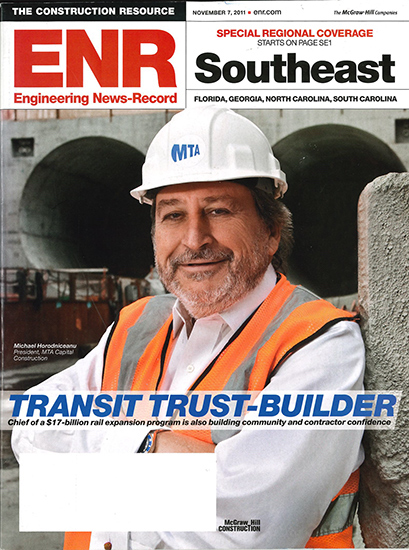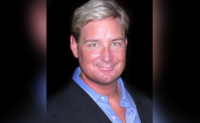Executive News
Obituary: Michael Horodniceanu, 78, Was NYC's Rail Megaproject Maestro

Michael Horodniceanu led development of complex NYC transit projects such as Second Avenue Subway, Fulton Transit Center and the No. 7 subway, and shared a passion for engineering with scores of students and future mentees.
Photo by Patrick J. Cashin/MTA

Horodniceanu, at MTA tunnel project site in New York City, ran one of the most complicated U.S. construction programs.
PHOTO: By MTA/Patrick J. Cashin
Michael Horodniceanu, former president of the New York Metropolitan Transportation Authority Capital Construction Co. who navigated challenges both technical and political to guide multibillion-dollar transit projects to completion, died June 22 of pancreatic cancer at age 78.
Born in Romania, Horodniceanu emigrated to the U.S. in 1970, where he became known as “Dr. H,” having earned a PhD in transportation planning and engineering from Brooklyn Polytechnic Institute that was later merged into New York University as its Tandon School of Engineering.
The school also was his last employer—where he was a professor and inaugural chair of its Institute of Design and Construction Innovation Hub until his death. The unit was created to engage construction participants and stakeholders to develop innovative approaches to industry challenges.
Horodniceanu joined city-based engineering company Urbitran in 1973, eventually becoming chair and CEO before it was acquired by AECOM. He later served as New York City Traffic Commissioner and joined MTA in 2008 to head its capital construction unit—newly formed to oversee major city transportation construction projects that included the Second Avenue Subway, Fulton Transit Center, East Side Access rail link and the No. 7 subway line extension on Manhattan's west side.
“Michael had an irresistible excitement about all things urban, engineering and transportation related,” said an online obituary. “He was larger than life with a colorful personality and colorful bowties to match.”
Jelena Kovačević, Tandon school dean and Magued Iskander, chair of its civil and urban engineering department, said in a joint statement that “his loss will be felt for years to come, but his contributions will live on forever.”

Horodniceanu was noted for humor, diplomacy and honesty, as well as engineering skill, to gain public support for controversial projects such as Second Avenue Subway, where he is shown above in 2013.
PHOTO: By MTA/Patrick J. Cashin
Featured in a 2011 ENR cover profile, Horodniceanu was notable for his humor, diplomacy and honesty to gain public support for controversial projects such as Second Avenue Subway. “I realized that shying away [from project critics] was the worst thing to do,” he told ENR. “I went uptown and walked into stores. I said, ‘Talk to me. Help us learn how to be a good neighbor.’”
Claire Shulman, former Queens borough president, said of Horodniceanu: “In government, it’s pretty rare in my experience to do difficult jobs and have a pleasant personality—to have people cooperate with you just because of who you are.”
Elliot “Lee” Sander, former CEO of MTA who hired Horodniceanu, noted on an online tribute site: “With brilliance, wit, panache, and rock solid integrity ... Michael made Second Avenue, the 7 Line extension, Fulton Center, and South Ferry a reality, and brought East Side Access/Grand Central Madison close to the finish line, shaping the city and region for decades to come.”
Gabrielle Shubert. former New York City Transit Museum director, added: "His accomplishments were enormous and he made it look easy."
Horodniceanu also sought to shape the next generation, frequently leading regional school group tours deep into city transportation projects and serving as co-chair of the city Public Schools Career and Technical Education Engineering and Architecture Commission for more than five years. "He brought an incredible commitment to encouraging young people to consider careers in these fields and supporting educators with how to bring engineering concepts into their classrooms," said commission participants in a tribute. "His love of this field came through in all of his interactions."
Adds Judy D. Cooper, a former Parsons Brinckerhoff senior executive who is associate director of the NYU hub: “The humanity of Michael—his caring spirit, humor, honesty and intense curiosity—was paramount in his approach to his work and to his life in general."
According to the obituary, donations can be made to the Pancreatic Cancer Action Network.






